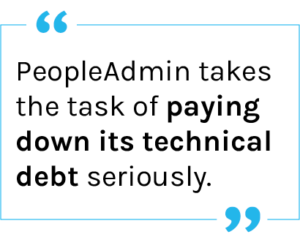How PeopleAdmin’s focus on reducing technical debt is opening the door to bigger platform updates.

Software companies are often fast-paced, fast-growing, and ever-adapting. Technology evolves quickly, and what was cutting edge one day might need to be updated the next to leverage the latest and greatest advancements. New innovations, products, and features are often the changes most visible to customers, but in any software company, there is also a constant need to keep updating underlying technical architecture to meet consumer desires and market need, keeping a company relevant in a competitive landscape. This backend maintenance might not be as visible to consumers, but PeopleAdmin considers it a top priority; we know it is vital to the well-being of any company or software product. When these under-the-radar changes go unaddressed, developers face a problem known as technical debt.
One software engineer compared technical debt to cleaning your house for an unexpected guest. In a rush, you have to stuff everything into a closet. The job is finished—the house looks clean to your guest. But the next day, you need to clean again. You open the closet door and everything falls out. Now, you need to organize the mess from yesterday, and throw away what you don’t need if you want to fit anything new in the closet. Technical debt is like that closet of built-up work: the time it takes to tackle it all at once can take away from time spent creating and innovating.
There is agreement, especially among the software developers who deal with much of the detangling work, that paying off technical debt is key to keeping customers happy and satisfied with the direction of the product. According to a 2020 survey by McKinsey, “some companies find that actively managing their tech debt frees up engineers to spend up to 50 percent more of their time on work that supports business goals.”
PeopleAdmin takes the task of paying down its technical debt seriously. With our twenty years of experience and multifaceted platform, we understand how quickly technology evolves and are committed to growing and updating our software in response to customer need and product feedback. This means that we are committed to diving into the back end, even when huge portions of that work fly under the radar. Our goal is to ensure that our product functions seamlessly for our customers and to provide up-to-date technology that reduces their daily pain points. Maintaining and building a modern and reliable back-end architecture is critical to that goal, even if it is work that our customers never see.
product feedback. This means that we are committed to diving into the back end, even when huge portions of that work fly under the radar. Our goal is to ensure that our product functions seamlessly for our customers and to provide up-to-date technology that reduces their daily pain points. Maintaining and building a modern and reliable back-end architecture is critical to that goal, even if it is work that our customers never see.
PeopleAdmin’s initiative to reduce technical debt has had many benefits. Our constant attention to this backend work has allowed us to make nearly four times more enhancements in our product releases, compared to releases in 2019, many focused on customer satisfaction. Customers’ feedback about this acceleration has been positive, especially around newly added functionality such as HTML editing and integrated I-9 and E-Verify processes with key partners in Higher Education. In the last two years, our diligence in upgrading back-end architecture has allowed us to continuously address customer enhancement requests while simultaneously delivering major solution extensions, such as the new Marketplace of Connectors built on PACx Technology, powerful new analytics across the products, and the Faculty Information System. This investment in technical debt reduction opens the door to accelerated and expanded innovation and updates in the future.
Technical debt is an unavoidable reality for software companies facing an ever-changing market. It’s important for consumers to understand the impact of this backlog of work on the product they’re buying. PeopleAdmin’s dedication to this work has unlocked an exciting future of innovation and acceleration for our product. For any software you use, knowing that the provider has a plan for reducing technical debt, tackling architecture issues, and reducing their maintenance backlog can make you more confident that you won’t be facing delayed releases, slow updates, or security and reliability issues in the future.